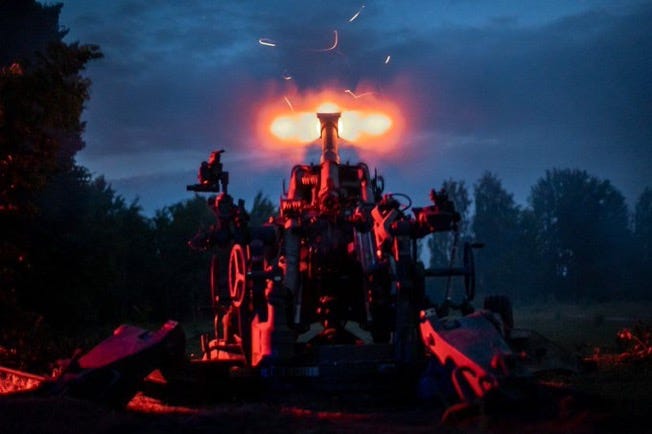MICK RYAN, AM

One of the great privileges of my three and half decades in the Australian Army was being able to command combat engineers. As a Troop Commander, Squadron commander (including in East Timor), Regimental Commander, command of a task force in Afghanistan and combined arms brigade commander, the sappers have been a constant presence in my professional life. Their cunning, professionalism, courage and humour is the right combination of attributes for those who often must sustain the mobility of combat forces at the tip of the spear.
So it is with great interest that I have been been following – where possible – the actions of Ukrainian army combat engineers in the defence of their homeland against the Russians. In the early days of the war, there was the story of the sacrifice of Vitalii Skakun , who stayed and executed a reserve demolition of the Henichny Road Bridge, in Kherson, in the face of a Russian advance. Later, we saw the analysis of a Ukrainian military engineer (Twitter - @kms_d4k) in the wake of the disastrous river crossing debacle by the Russians.
Now, the role of combat engineers has again come to the fore as the Ukrainian Armed Forces seek to break the Surovikin Line in southern Ukraine. The recent article on this topic in The Economist was excellent. And while most armies seek to avoid the very complex and bloody undertaking that is a combined arms obstacle breach, in southern Ukraine the Ukrainians have little choice. They need to take back their territory, and destroy Russian occupying forces. This means finding weak points and attempting to breach the Surovikin Line to then create an operational breakthrough.
Before discussing the Ukrainian efforts to breach and breakthrough in the south, it is worth a quick review of the Russian defensive layout that has been constructed over the past 6-7 months.
The Surovikin Line
The Russians spent over half a year developing their scheme of defence in south Ukraine. They were mainly the initiative of then overall Russian Commander General Surovikin. These defences were initially designed to stop Ukrainian forces overwhelming exhausted Russian forces in the wake of the Kharkiv and Kherson offensives. They assumed even greater importance once the Ukrainian 2023 offensive began in June.
There are several excellent resources that provides maps of the Russian defensive zones that have been constructed throughout southern and eastern Ukraine. Two of the best are those compiled by Brady Africk (find his work here), and the Institute for the Study of War (see their live map here).
One of the best analyses of the overall layout, composition and intent of the Surovikin Line has been produced by the Center for Strategic and International Studies (CSIS). It describes how:
To shift the offense-defense balance in its favor, Russia has designed one of the largest defensive systems in Europe since World War II. It has constructed a line of fortifications roughly 2,000 kilometers long, running from Russia’s border with Belarus to the Dnipro Delta. Approximately 1,000 kilometers of these defenses are located in Ukraine itself, where essentially all conventional warfare between Russia and Ukraine has taken place. Russia’s fieldworks include four semi-independent defensive systems, each of which roughly corresponds to a Ukrainian oblast.
The CSIS report breaks down the defences into four oblast-centric systems. Of particular interest are those in Kherson and Zaporizhia. These contain fortified forward security zones as well as main defensive lines. The depth of the Surovikin Line varies but can be many kilometres deep. It contains minefields, anti-tank obstacles and trenches as well as strong points.
I recommend reading the entire report from CSIS https://www.csis.org/analysis/ukraines-offensive-operations-shifting-offense-defense-balance
The intent of these obstacles vary depending on geography and the overall plan of military commanders. But generally, obstacles can be used to ‘turn’ an enemy force into a engagement area, ‘disrupt’ their formations by breaking up mounted and dismounted forces, to,’fix’ an enemy force in certain terrain to engage them, or ‘block’ them so they can be engaged and destroyed before reaching designated objectives. Each requires different levels of investment in obstacles, with ‘block’ obstacles requiring the most time and resources to construct.
Besides the physical defences, obstacles are covered (as we say in the Army), by observation and fires.
Covered by observation means that multiple layers of reconnaissance and surveillance are used forward of, and above, these obstacle zones. Ground and aerial forces often conduct delaying actions in the security zone, although this is not always the case. Extensive use of crewed and uncrewed platforms in the air and on the ground, as well as ground sensors, electronic warfare and radars – and the Mark 1 eyeball - can be used to maintain observation of obstacles as well as the most likely ground approaches to the obstacles, and from the near side of the obstacles to anticipated enemy objectives.
Covered by fires means that direct and indirect Army (and Air Force) fires are able to engage an enemy in their approach to obstacle zones, during any breach activity, as well as in their maneuver from the obstacle to objectives. Both precision and suppression is required, and this might include howitzer and rocket artillery, mortars, a range of direct fire crew served weapons, armoured vehicles as well as attack aviation. Importantly, covered by fires should also include non-kinetic means. Thus, electronic warfare is part of the mix. It is especially important just as enemy breach activities commence, which is one of the best times to distrust their communications and sharing of situational awareness.
No comments:
Post a Comment